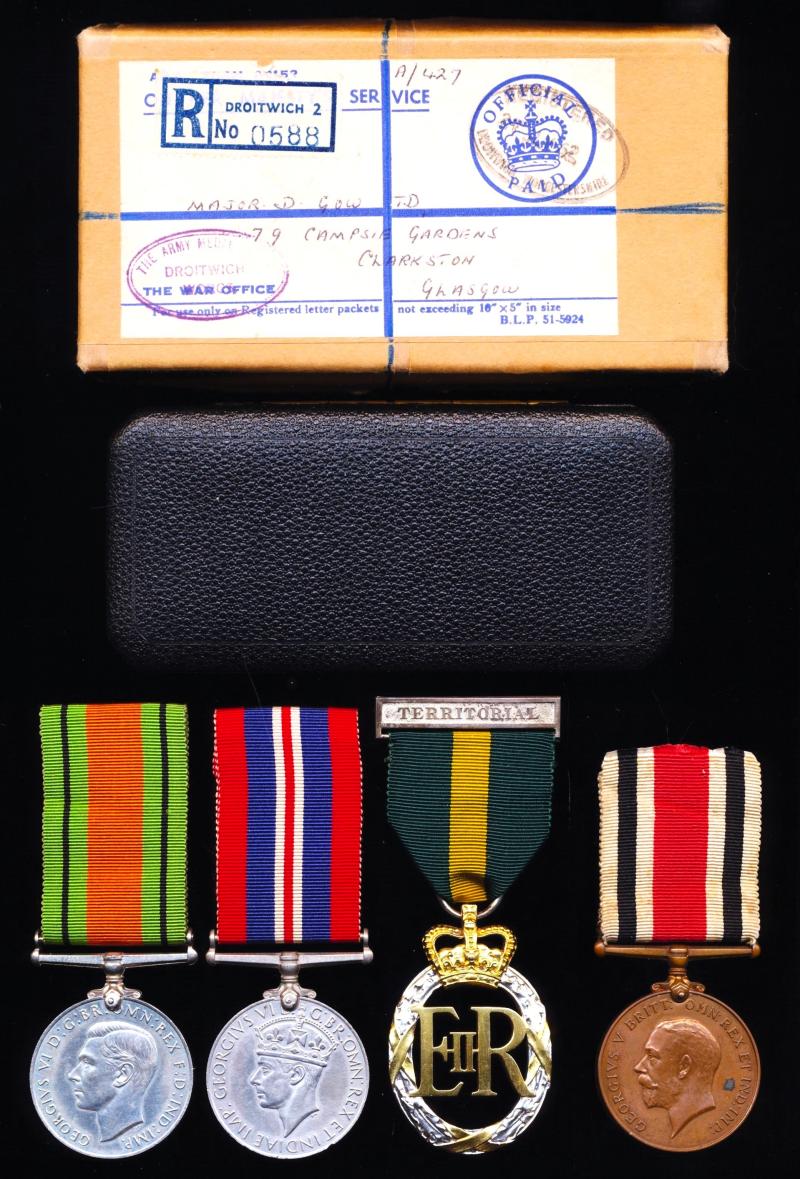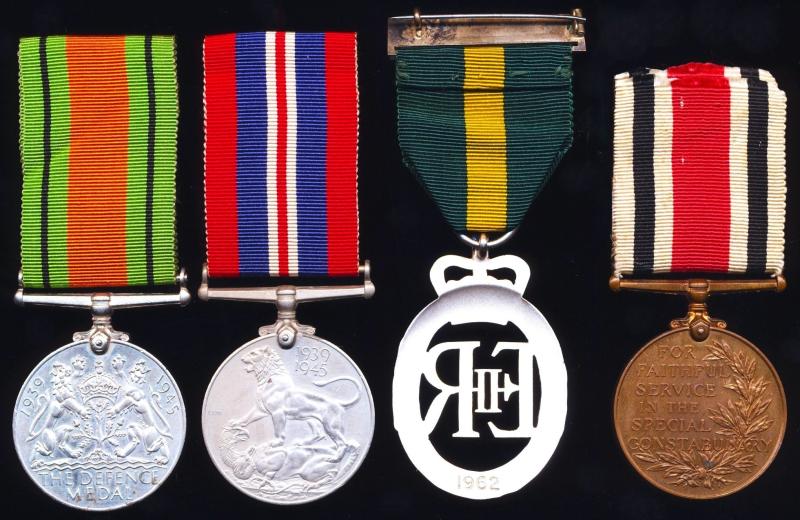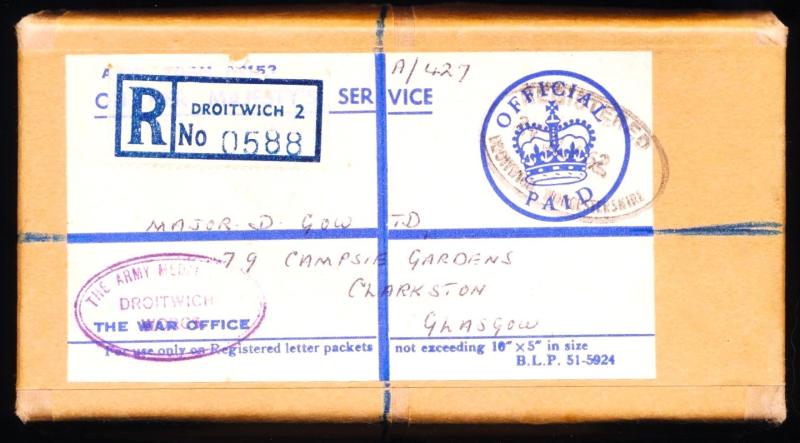A 'Dunfermline' Officer's Second World War & Family Long Service Group of 4: Major David Gow, T.D., Royal Regiment of Artillery late 227th Anti-Aircraft Battery Royal Regiment of Artillery & his Father, Andrew Gow, late Dunfermline Special Constabulary
Comprising:
A). Father: Andrew Gow (Tailor & Clothier)
- Special Constabulary Long Service Medal. GV 'Second Type' Coinage Head issue (Andrew Gow.)
For service with the Dunfermline Special Constabulary
Andrew Gow, eldest son of David Gow (Tailor & Clothier) and Christina Gow (nee Brodie) was a native of Dunfermline, Fife, Scotland, where he was born in 1877, and where he was baptized on, 6 December 1867. Per the 1891 National Census for Scotland, Andrew is recorded described as a 'Scholar' and residing with his parents and 4 x siblings (2 x sisters, Christina & Jessie, and 2 x brothers, David & Thomas/) at the family residence located at Glencairn Cottage, 129 Grieve Street, Dunfermline, Fife. Scotland. By the time of the 1901 Census, Andrew was shown employed in the family business described as a Clother's Manager, while his mother is shown as a Widow, employed as a 'Clothier' The 1901 Census also records another sibling for Andrew, his youngest brother James L. Gow, who had been born in 1891, shortly after the previous Census. Andrew Gow is recorded to have died at Dunfermline on, 20 May 1945. The executors named in the 'Confirmation' (Probate) were his widow, Esther Gow (nee Walker) and his eldest son, Major David Gow H.M. Army!
Condition: Minor stains, thus VF
B). Son: Major David Gow, Royal Regiment of Artillery late 227th (Fife) Anti-Aircraft Battery Royal Regiment of Artillery
- Defence Medal
- War Medal
- Efficiency Decoration (Territorial Decoration). EIIR issue. With clasp 'Territorial'. Reverse dated 1962
Sold together with official Royal Mint hinged cased of issue for the T.D., this contained in original card box of issue from the Army Medal Office, Droitwich, The War Office, addressed to Major D. Gow, TD, 79 Campsie Gardens, Clarkston, Glasgow
Medals verification: Although the British Army medal rolls for the Second World War are not in the public domain - Major Gow, was clearly entitled to the awards of the Defence Medal & War Medals for 'Home Service' in the United Kingdom during the Second World War. His retroactive award of the Efficiency Decoration as published in the London Gazette issue below cited:
- Defence Medal: For 3 years 'Home Service' 1939-1944
- War Medal: For 28 days service
- Efficiency Decoration (T.D.): LG 19 January 1962, shown as Capt. (Hon. Major). D. Gow (74367). Retired
David Gow, eldest son of Andrew Gow (Clothiers Manager) and Esther Gow (nee Walker) was a native of Dunfermline, Fife, Scotland, where he was born on, 15 July 1909, and where baptized on 19 September 1909. With war clouds gathering in 1938, David volunteered for the Territorial Army and was commissioned as a Second-Lieutenant (with unique British Army Officer number (74367) and posted to his local Gunners unit, viz 227th (Forth) Anti-Aircraft Battery, Royal Artillery (London Gazette issue of 8 March 1938 refers). David's engagement to Elizabeth 'Betty' Hutton Maclean at Oban, Argyllshire, Scotland, only daughter of Mr. Angus Maclean of Skerrols House, Bridgend, Isle of Islay, Scotland, was announced in the Campbeltown Courier issue of 16 March 1942, by which time he was holding the rank of Captain. On 30 September 1944, the couple experienced a grievous loss, when a baby son who was born in Edinburgh, but tragically did not long survive his birth. By the time of their sad loss, David Gow was holding the rank of Major
Photograph of Captain David Gow: Reference the Aberdeen Press and Journal issue of 27 July 1940, there is a wedding article and accompanying wedding photograph, whereat Captain Gow -in Officers service dress - was acting as 'Best Man' to a fellow Gunner Officer 2nd Lieutenant Garry Drysdale, R.A.,from the same unit. In the photograph, Captain & Mrs. Gow are standing immediately behind the married couple, with David's three crowns 'officer pips' insignia clearly on display
The Supplement to the London Gazette issue of 1959 contained the official notice pertaining to the retirement David Gow from the Territorial Army Reserve of Officers, vis 'having exceeded the age limit, cease to belong to T.A. Res. of Offrs., 7th Oct. 1959, retaining the hon. rank of Maj.....
Major David Gow is recorded to have died at Morningside, Edinburgh, Scotland, sometime in 1988. His body was buried at St. Marks Episcopal Churchyard, Portobello, Edinburgh, Scotland. David's wife had predeceased him in 1975, and the couple now rest together in the same churchyard
36th (Scottish) Anti-Aircraft Brigade was an air defence formation of Britain's Territorial Army, created in the period of tension before the outbreak of the Second World War. It was responsible for defending eastern Scotland. 36th (Scottish) Anti-Aircraft Brigade (36 AA Bde) was formed on 1 May 1938 at Edinburgh, to command the units responsible for the air defence of Edinburgh and the Firth of Forth. Initially the brigade was formed within Scottish Command, later being subordinated to 3rd Anti-Aircraft Division when that formation was raised at Edinburgh on 1 September 1938 to command all the AA defences of Scotland and Northern Ireland. Subsequently, Anti-Aircraft Command was created on 1 April 1939 and took control of AA Defence throughout the United Kingdom. The TA's AA units were mobilised on 23 September 1938 during the Munich Crisis, units manning their emergency positions within 24 hours, even though many did not yet have their full complement of men or equipment. The emergency lasted three weeks, and they were stood down on 13 October.6 In February 1939 the existing AA defences came under the control of a new Anti-Aircraft Command. In June a partial mobilisation of TA units was begun in a process known as 'couverture', whereby each AA unit did a month's tour of duty in rotation to man selected AA and searchlight positions. On 24 August, ahead of the declaration of war, AA Command was fully mobilised at its war stations. The Order of Battle of 36th (Scottish) Anti-Aircraft Brigade, on the outbreak of the Second World War in September 1939, comprised:
The composition of 36 AA Bde on the outbreak of war was as follows:
71st (Forth) AA Regiment, RA – formed 1938 from independent AA batteries
HQ at Dunfermline
227 (Fife) AA Bty at Dunfermline
228 (Edinburgh) AA Bty at Edinburgh – formed cadre for 94th AA Rgt
229 (Fife) AA Bty at Dunfermline
94th AA Regiment, RA – formed April 1939
HQ at Turnhouse
228 (Edinburgh) AA Bty – from 71st AA Rgt
291 AA Bty at Turnhouse
292 AA Bty at Musselburgh
101st AA Regiment, RA – formed August 1939
HQ at Inverness
226 (Caithness and Orkney) AA Bty at Kirkwall – previously independent battery
297 (Inverness) AA Bty at Inverness – previously independent battery
36 Anti-Aircraft Brigade Company, Royal Army Service Corps
In September 1939, the brigade had 28 heavy AA guns deployed round the Forth, with one more out of action
Condition: The SCLSM medal VF, the others EF - the TD pristine
Code: 24070







